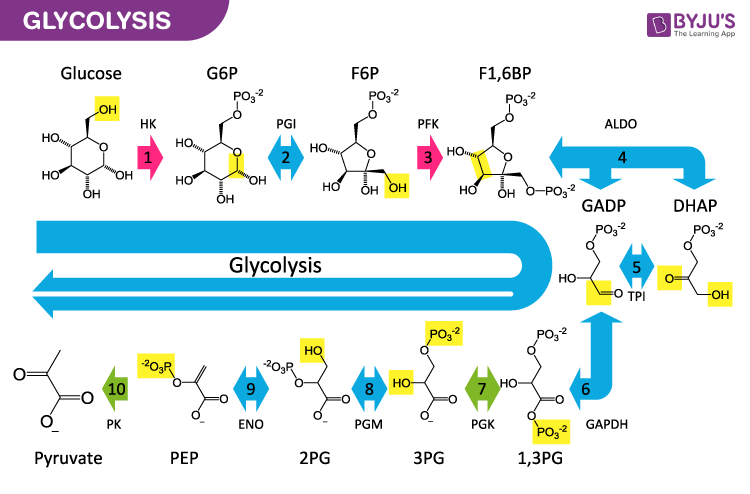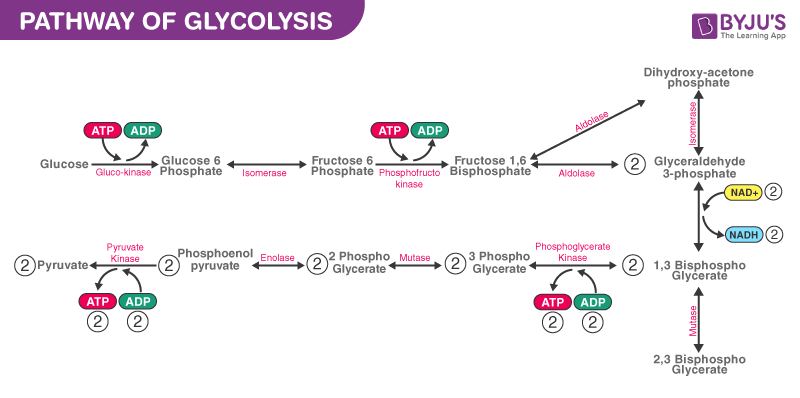“Glycolysis is the metabolic process that converts glucose into pyruvic acid.”
What is Glycolysis?
Glycolysis is the process in which glucose is broken down to produce energy. It produces two molecules of pyruvate, ATP, NADH and water. The process takes place in the cytoplasm of a cell and does not require oxygen. It occurs in both aerobic and anaerobic organisms.

Glycolysis is the primary step of cellular respiration, which occurs in all organisms. Glycolysis is followed by the Krebs cycle during aerobic respiration. In the absence of oxygen, the cells make small amounts of ATP as glycolysis is followed by fermentation.
This metabolic pathway was discovered by three German biochemists- Gustav Embden, Otto Meyerhof, and Jakub Karol Parnas in the early 19th century and is known as the EMP pathway (Embden–Meyerhof–Parnas).
Also Read: TCA cycle

Glycolysis Pathway
The glycolysis pathway occurs in the following stages:

Stage 1
- A phosphate group is added to glucose in the cell cytoplasm, by the action of enzyme hexokinase.
- In this, a phosphate group is transferred from ATP to glucose forming glucose,6-phosphate.
Stage 2
Glucose-6-phosphate is isomerised into fructose,6-phosphate by the enzyme phosphoglucomutase.
Stage 3
The other ATP molecule transfers a phosphate group to fructose 6-phosphate and converts it into fructose 1,6-bisphosphate by the action of the enzyme phosphofructokinase.
Stage 4
The enzyme aldolase converts fructose 1,6-bisphosphate into glyceraldehyde 3-phosphate and dihydroxyacetone phosphate, which are isomers of each other.
Step 5
Triose-phosphate isomerase converts dihydroxyacetone phosphate into glyceraldehyde 3-phosphate which is the substrate in the successive step of glycolysis.
Step 6
This step undergoes two reactions:
- The enzyme glyceraldehyde 3-phosphate dehydrogenase transfers 1 hydrogen molecule from glyceraldehyde phosphate to nicotinamide adenine dinucleotide to form NADH + H+.
- Glyceraldehyde 3-phosphate dehydrogenase adds a phosphate to the oxidised glyceraldehyde phosphate to form 1,3-bisphosphoglycerate.
Step 7
Phosphate is transferred from 1,3-bisphosphoglycerate to ADP to form ATP with the help of phosphoglycerokinase. Thus two molecules of phosphoglycerate and ATP are obtained at the end of this reaction.
Step 8
The phosphate of both the phosphoglycerate molecules is relocated from the third to the second carbon to yield two molecules of 2-phosphoglycerate by the enzyme phosphoglyceromutase.
Step 9
The enzyme enolase removes a water molecule from 2-phosphoglycerate to form phosphoenolpyruvate.
Step 10
A phosphate from phosphoenolpyruvate is transferred to ADP to form pyruvate and ATP by the action of pyruvate kinase. Two molecules of pyruvate and ATP are obtained as the end products.
Key Points of Glycolysis
- It is the process in which a glucose molecule is broken down into two molecules of pyruvate.
- The process takes place in the cytoplasm of plant and animal cells.
- Six enzymes are involved in the process.
- The end products of the reaction include 2 pyruvate, 2 ATP and 2 NADH molecules.
Also Read: Difference between Glycolysis and Kreb’s cycle
To know more about glycolysis, its definition and the glycolysis pathway, keep visiting BYJU’S website.


I wish to join byjus coaching
Notes is good